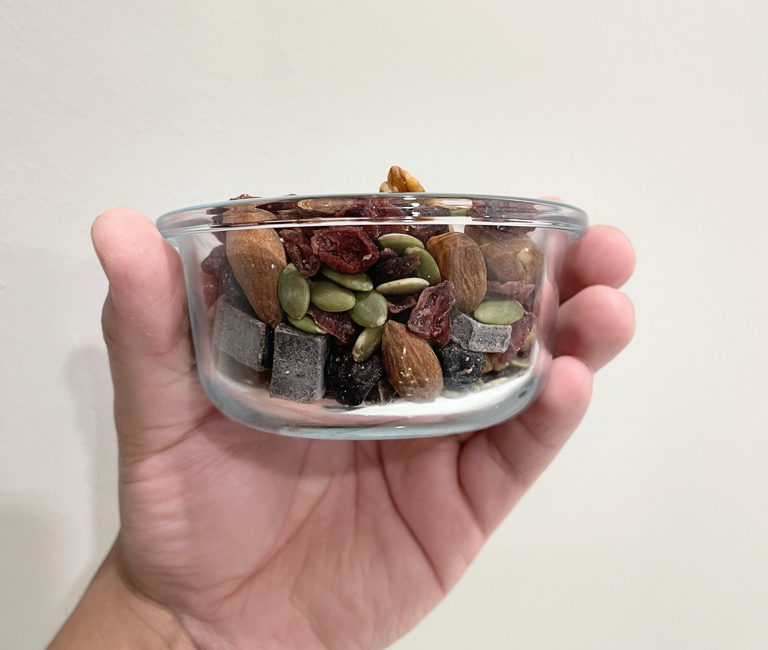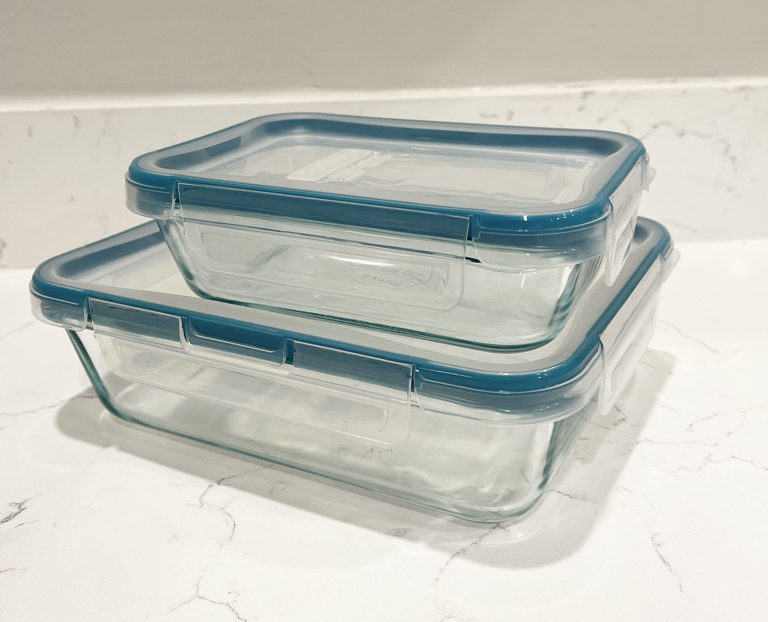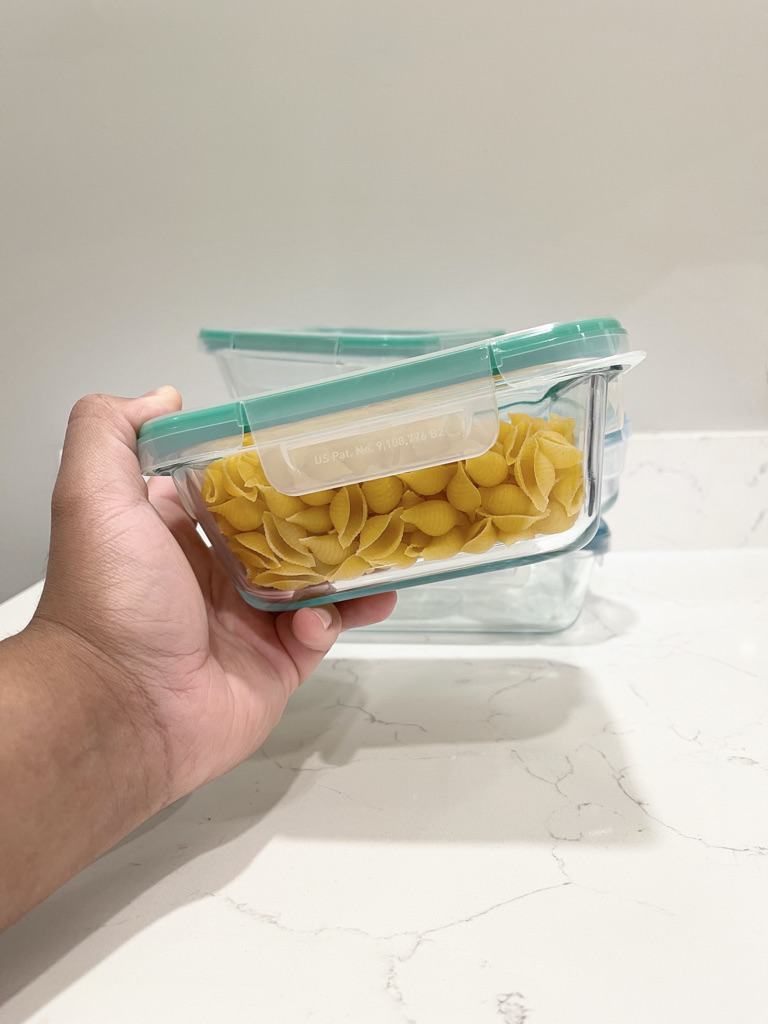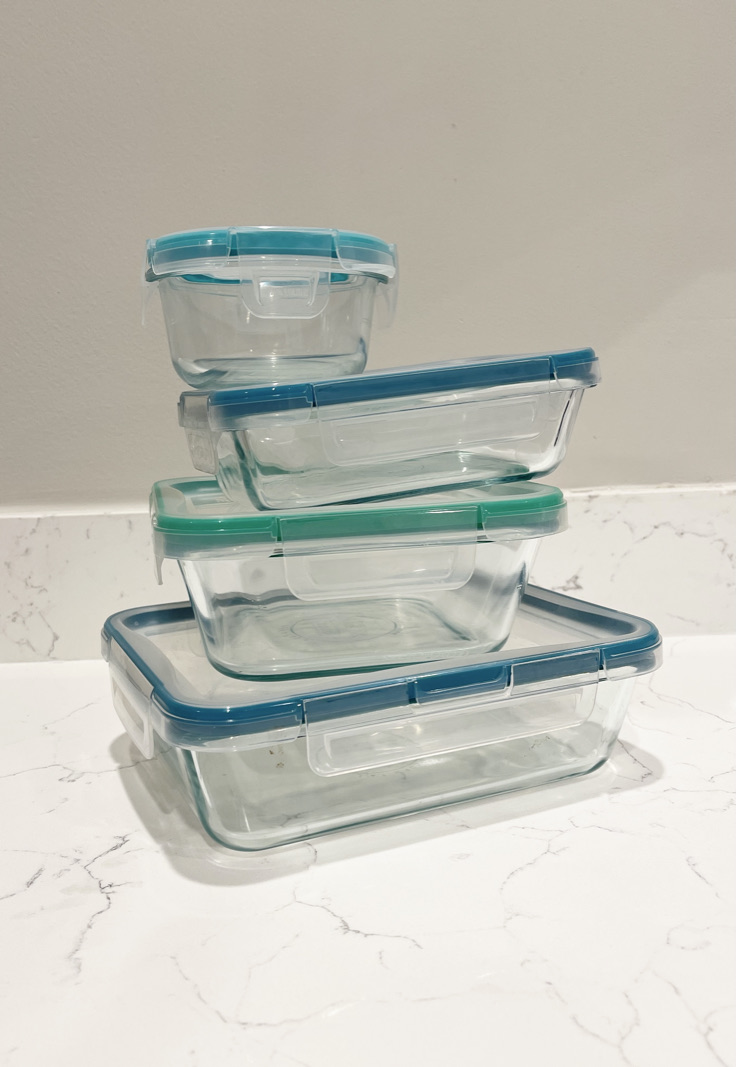Food storage is a popular talking point in sustainable and eco-friendly circles. That’s because there are so many options out there and so many of them are wasteful. Snapware has been my go-to food storage choice for years but there are some things to consider before making a purchase.
I’m a clumsy person and the idea of incorporating glass food storage into my daily routine seemed a little nerve racking at first. This Snapware review will cover all my woes and all the things I love about their products, helping you decide whether or not Snapware will or should become a staple in your daily routine too. Let’s dig in!
Sustainably is supported by readers like you. When you buy through links on this site, we may earn an affiliate commission at no additional cost to you. You can read more about affiliate links on our “About” page.
Ratings
Overall Score
Function
Durability
Ease of Use
Appearance
Packaging
Do I recommend this product?
As if there was any question after those wonderful scores, yes, I do recommend Snapware’s glass containers. Without any hesitation I would recommend these to any and everyone, and there are a bunch of reasons. Let’s break down why I gave Snapware the ratings I did first by section, and then I’ll cover additional questions you might have.

Does it get the job done? (Function)
Yes, it does. The goal for food storage is pretty simple, to store food. But for sustainable shoppers like you and me, it’s more than just storing food. We also want something that’s going to last a really long time and give us great versatility. Both of those things help us reduce and reuse more and more. Snapware’s glass containers do just that, working for me in every part of the kitchen and step in food storage/prep.
The main reason I prefer Snapware’s glass containers is because I can use it in the oven, microwave (the lids are BPA free), fridge, and freezer! It’s dishwasher safe so cleaning is a breeze.
The biggest thing for me here is that it’s microwave safe, because many other metal storage containers are not microwave safe. And to me, that just means adding more dishes to the dirty pile.
Is it durable?
Yes! To be clear, I haven’t put them through a “rugged durability” test of any sorts (other than daily life) but I’ve had them for the better part of a decade and they’re still as good as the day I got them.
I have dropped my Snapware containers from counter height a couple times before and they surprisingly survived but I wouldn’t push your luck. Proceed with caution if you have tiny humans too. Maybe something like Stasher would be more appropriate for them, just in case.
Because the lid is plastic, there is a little bit of staining from pasta sauce. I haven’t taken any issue with this because staining is going to happen with almost any material. I just use the same 2 or 3 containers when storing sauces like that in order to avoid having a cabinet full of orange-red lids.

Ease of use?
They are super easy to use, there’s really nothing special to it. Learn from me, if you microwave with the lid, make sure it’s not sealed or you risk warping the lid.
Also, the lids take a little extra time in my experience. Just because there’s a little gap right inside where the lid seals with the glass. It’s not so small that you can’t clean it if needed, but it does tend to hold water a bit longer for me when drying.
The whole container can go right in the dishwasher, making clean up easy. I’ve had no trouble getting baked-on messes off, or any other mess for that matter. And I’ve been able to test them in many different dishwashers over the years too.
The glass is Pyrex glass and it lives up to the name well! It hasn’t chipped at all for me, they haven’t scratched, or stained.
Do I want to show it off? (Appearance)
Yes, that’s the inner bougie in me coming out though. Because they don’t stain as easily or scratch, glass containers just look nicer for much longer compared to plastic.
But they’re also just more versatile! People always love that I can just throw my food storage containers into the oven (without the lid of course) to bake a delicious meal. That kind of versatility seems to really slip the minds of most people when they think about how they store their food.
The versatility of these containers is especially useful come holiday season when I visit family. I bring a cooler and a bunch of these home with me, and I can always get tons of leftovers and premade meals. Stick them in the freezer, thaw in the fridge, and heat in the oven once I’m ready to chow down. All without changing containers too.
Is the packaging appropriate?
I can’t speak to how the products ship when you order online. I imagine that’s a very different experience considering you’re shipping glass products. But buying them in person at the store comes with very little packaging. There’s just a paper insert with instructions, care, and other info and you can easily recycle that. There’s nothing else packaging wise.

Snapware Pros & Cons
Pros
- Microwave Safe
- Dishwasher Safe
- Oven Safe
- Freezer/Fridge Safe
- BPA Free
Cons
- Plastic Lid
- Not a “Sustainable” brand
- Expensive Upfront
What is Snapware (the brand)?
Snapware is a company on its own. They make food storage for the kitchen. But it is also an Instant brand. Other Instant brands include Pyrex, Corning Ware, and Corelle. You probably recognize the name from InstantPots and other common kitchen appliances.

What options do I have to buy?
What options do I have to buy? They have a lot of options for you to choose from and I have tried all of them except for 1, the 1-Cup square container (4.25” wide x 4.25” deep x 2.25” high). Minus that one exception, I own at least one of everything else. Here’s what they have:
- 2-Cup Rectangular Glass Container (7” wide x 5” deep x 2.5” high)
- 1-Cup Round Glass Container (4.25” diameter x 2.25” high)
- 4-Cup Round Glass Container (6.5” diameter x 3.25” high)
- 4-Cup Square Glass Container (6.75” wide x 6.75” deep x 3” high)
- 6-Cup Rectangular Glass Container (9” wide x 7” deep x 2.75” high
They sell them directly on their website. You can also find them at Walmart and Target too though.
Cost and Comparability
I have to be honest here, I’m writing about cost from a place of privilege. I was able to buy these as a single person just starting college. So when I dropped the big bucks on these glass food containers I wasn’t also managing a budget or a family of any kind. With that said, these are definitely more expensive than plastic alternatives.
Compared to the thin and somewhat disposable plastic containers on the same aisles, these will probably run you 4 times as much for 1 container. Still, I absolutely still recommend them.
Just like with many other sustainable options, your swap might be more expensive but they will likely outlive the cheaper more harmful product. That’s especially true if you treat them right.
Unless you don’t have any food storage containers at all, then you probably shouldn’t be buying too many anyways. Remember, you want to use what you have first and add new items as needed. If you buy a bunch of Snapware containers and throw out your plastic containers, you haven’t actually helped anything. Instead you’ve actually created waste where there didn’t need to be any.
So if you’re buying them slowly, then the price becomes much more accessible because it’s spread out over time. Even I started with one or two and as I saw I used them regularly I would add one to my cart each time I went shopping. I recommend a similar approach with Stasher bags in my blog post about them LINK.
If you approach the transition like that, then I think the cost is a little bit easier to swallow.
Now if you compare the cost of Snapware’s glass containers to other popular sustainable containers then the price is right on par with the competition.

What makes Snapware a sustainable choice?
First of all, I should address the fact that some people might not consider it a sustainable choice. Let’s talk about that first.
Snapware isn’t itself a “sustainable” brand. And, it obviously still has a plastic lid. Compared to more sustainable brands like U-Konserve and Klean Kanteen (both of which are B Certified and partners of 1% for the Planet LINK LINK) they actually seem like a poor choice. They may be for you. If you’re absolutely not okay with a plastic lid or would prefer to support a B Certified brand, etc. then this is not the brand for you.
But, if you’re just looking for an excellent food storage option, that will last you basically forever and fit your needs then this could be the choice for you. Many people choose Snapware, even within the eco-friendly and sustainability community.
I would love to switch to stainless-steel/silicone containers but the fact is, unless you exclusively eat cold foods that don’t need to be heated/reheated in a microwave then stainless isn’t going to work for you. Many of us need food storage that can go into a workplace microwave at the very least.
Ultimately, I still consider these a sustainable swap because they are a replacement for plastic containers. Glass containers just last better and longer than plastic containers.
Most plastic containers could last you “forever” but it’s generally recommended you replace them between 5 and 10 years. That’s if you manage to avoid losing them or misplacing a lid and rendering it useless.
Glass can last indefinitely and it can be completely recycled when you’re done with it. Even better, a lot of glass containers can be found at thrift stores.
So as long as you treat your glass containers well, use what you have first, and hold onto them for a very long time, then Snapware’s glass food storage containers can absolutely be an excellent swap for you. I wholeheartedly recommend them.
Thanks for joining me today! If you liked this content and want to see more, please subscribe to my newsletter. You can do that here!
In case you didn’t catch my posts about sustainable things coming in plastic packaging, you can check it out here.
Sustainably is supported by readers like you. When you buy through links on this site, we may earn an affiliate commission at no additional cost to you. You can read more about affiliate links on our “Affiliate Marketing…” page.
Pingback: 9 Ways You Can Waste Less During Holiday Gatherings - Sustainably